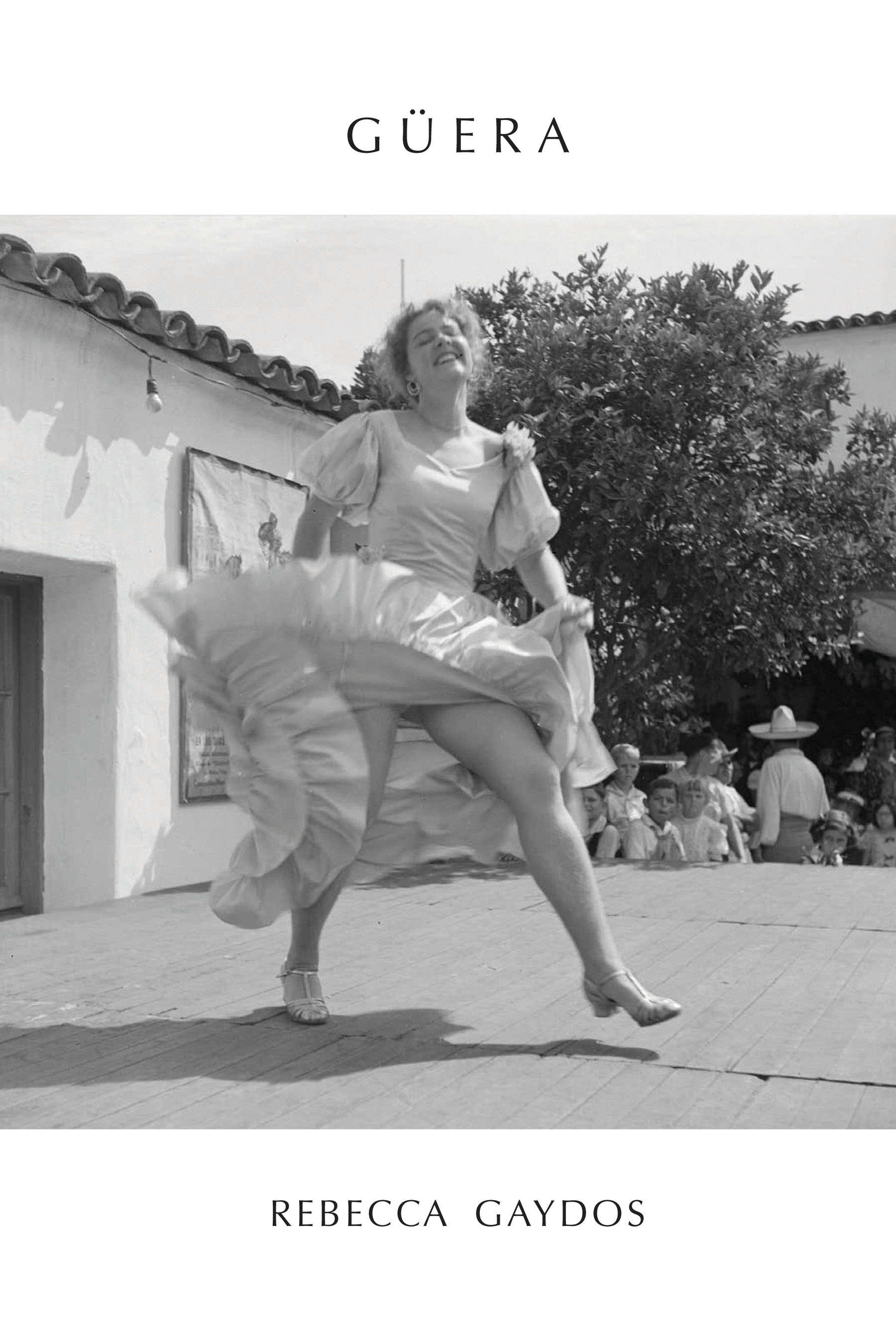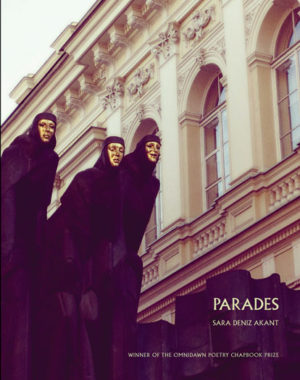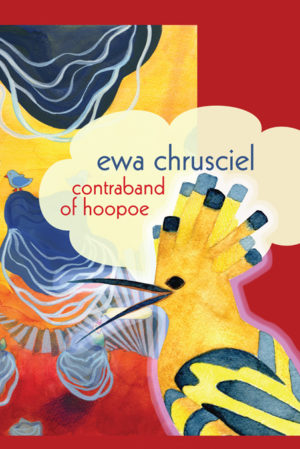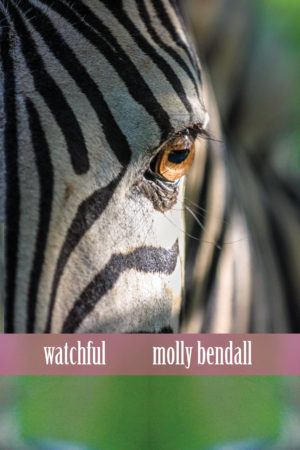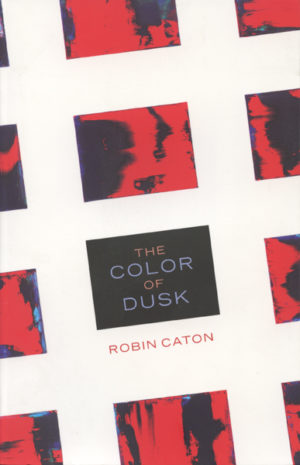Description
Invoking a Mexican slang term that translates roughly as “white girl,” Güera considers how the body’s intelligibility—its public meaning as a racialized, gendered, and sexualized surface—shifts as it crosses linguistic and national borders. Gaydos’s disarmingly direct addresses slip between the spaces of story and reality, traversing the many meanings of “appearance”: not only the physical image and its attendant assumptions, but also the act of arriving or becoming visible. Moving between Los Angeles, Oaxaca, Mexico City, and Talcott, Virginia, Güera traces the way touristic desire, folklore, and stereotype transform the languages we speak, as well as the bodies we inhabit.
Rebecca Gaydos is no maker of sweet images. Instead, this amazing and fearless book, this Güera, takes on production itself. Gaydos pursues not incidents but the shape of incidents butting up against one another to produce the dubious and mercantile cultures of our world—that is, she makes her readers aware of the “the facts after the facts.” But Güera also acknowledges (and discerningly celebrates!) strip poker, miscegenation, tattoos, and love. The book is a book of telling inquiry. Güera—“comparative, adjectival, always interpolating”—is uncomfortable work in the very best senses.
C. S. Giscombe
Rebecca Gaydos uses the context of the Güera to anti-critique “identity’s interstices” in a diary of namings, brushes with history, and incursions into the contradictory discourse of racism. Güera is whiteness in a complex racial community, and guera is derogatory and colonial. Gaydos also reminds us that guera is “a wide-mouthed way to talk about look,/ to sound off in the street, to address, to flag, to get up on what’s obvious, what/ appears here.” In its brashness, this collection makes a great commentary about the informal ways we assert power over one another, how language and subject-building make uneasy bedmates.
Carmen Gimenez Smith
The word güera is, in Chicano and Mexican-Spanish slang, a term for a white girl. It is mildly derogatory (as all such categorical terms are) and inevitably alienating, even (or especially) if one applies it, or finds it applied, to oneself. It is fictive (making one into something that others see), but it is also political, in ways that fictions often are. Nestled into disparities of identity and the awkwardness of being racialized (“white”), the poems of Güera, which are poems written by a güera, exercise the restraint that fiction requires if it is to be true. It is likely that there is a close connection between the “white girl” of this book’s title and its author. But Rebecca Gaydos is far too intelligent, and far too fine a poet, to flood that connection with narcissistic abjection. As she notes toward the end of the book, “Fault was a weak bastard, disinherited, unable to determine clean up duty, / unable to give me my true lot in life.” It seems that it is life itself that gives Gaydos her lot—and it is a lot: vitality, resilience, wit, love, as manifest in the restless, wonderful poems that comprise this unforgettable book.
Lyn Hejinian
About the Author
Reviews
Excerpt
Rebecca Gaydos was born in Santa Barbara, California, where her mother and father worked as professional ballet dancers. At UC Berkeley, she won the Eisner Prize in Poetry and earned her Ph.D. in English. She has taught literature and writing at Diablo Valley College, San Quentin State Prison, and UC Berkeley. Currently, in addition to writing poetry, she is editing an unpublished novella by poet Larry Eigner and completing a scholarly book on the significance of technoscientific thought in post-World War II American poetry.
A brief interview with Rebecca Gaydos
conducted by Gillian Olivia Blythe Hamel
I was thrilled to see this manuscript come to Omnidawn. I’d never read anything that was so enigmatically direct—your line has a distinctive way of stating things so plainly that words and phrases seem to have an obvious meaning masking something more subversive, showing the veil of ideation and pulling it off at the same time. I wonder if you could talk about this in terms of the way translation and meaning are at work in this book—and not only translation but mistranslation, misrepresentation, misapprehension—the title, for example, is never fully explained but given some askance interpretations/etymologies. How does language’s ability and simultaneous inadequacy to reveal inform your work?
I like plain language, language that isn’t trying to be beautiful or poetic. And I like the idea that poetry—whatever that might be—might be happening someplace other than on the level of language. But, then, it’s never really clear to me where language starts and stops. So it’s pretty difficult to talk about these kinds of things. But I am intrigued by the idea of seeing how plain things can be. How obvious can things get? And then what happens? In a recent English class I was teaching, my students and I were discussing the politics of reclaiming derogative terms. We had just read Susan Stryker’s great essay, “My Words to Victor Frankenstein,” which talks of the political potential of words like “creature,” “unnatural,” and “monster”—words that are routinely directed as insults against transgendered people, but which, according to Stryker, have the potential to reveal the “seams and sutures” that run through everybody. I asked my students to think of other reclaimed words, ones that Stryker hadn’t mentioned. One student mentioned the word “bitch,” her point being that sometimes when someone calls you a “bitch,” you accept it, you say, “Okay, sure, I’m a bitch,” and you do this because you want to move things along. It’s a way of raising things to the next level, of pushing the moment forward. Now that I’m bitch, what follows from that? If this is true, then what else is true? Does something need to follow from this? Can something follow from this? My student’s understanding of accepting the term “bitch” is somewhat different from the way Stryker thinks about language. In any case, it definitely struck a chord with me. I keep coming back to the idea and the feeling of moving things along. And I think language plays a huge role in that. But maybe it’s the movement that’s the poetic part. I try not to be too concerned with what happens verbally. But it’s hard because we use words so often, and so casually. One of my favorite poets, Larry Eigner, would sometimes try to distinguish poetry from “table talk.” I’m not sure how much he believed in this—or any—distinction, but it’s a pretty good starting point… until you double back and become mesmerized by the table talk.
In his endorsement of this book, C. S. Giscombe (who also introduced us to your work) called it “uncomfortable work in the very best senses,” and I’d certainly agree that this work deals in a frankness that doesn’t romanticize its images. Questions of gender, race, nationality, and mass culture are tackled with equal ferocity; your line “my own image, the basic transaction” stands out to me as an encapsulation of the way cultural exchange can be ruthlessly mercantile. In conjuring such mercenary images, were there any passages in this book that particularly challenged or discomforted you as you explored them?
Definitely. There were many. Looking at my shape as a white woman, and as a citizen of a nation that claims to be the most powerful nation on the planet; looking at the eros of racial identification and misidentification; trying to figure out why people want to fuck each other; trying to step away from the sentimental so as to catch figures that “look like me” engaged in acts of violence, in long histories and stories of violence; not wanting to smooth over misogyny (not even over my own misogyny), not wanting to turn away from it because I want to see what it looks like, because I keep obsessing over what it feels like—these are major challenges.
But on a more fundamental level, I feel very uncomfortable with the Spanish phrases in my book. When I’m giving a reading, I want to skip over them. I don’t even want to say the title of my book aloud! Everyone will hear my gringa accent. And it’s not that easy to say, well, isn’t that the point? I wish I spoke good Spanish. But, then, I am a native English speaker, I have a Ph.D. in English, and there are a lot of English words that I regularly mispronounce (depending of course on where I am and who’s keeping track). So sound, speech, voice—I guess that’s a very volatile area, not just for me of course, for a lot of people.
There’s a peculiar relationship to narrative at work in this book: rhetorical flourishes that misdirect whether we as readers are in the space of experience or recounting experience abound. In speaking of poetry and diegesis (as in a shared and enclosed experience of narrative) G. C. Waldrep notes that “poetic speech … steps out of (or away from, or into) the narrative fabric of shared experience in precisely the same way a cinematic soundtrack (non-diegetic sound) steps out of or away from or into the narrative body of the film.” Would you talk about how in your work poetic speech relates to and/or is distant from narration, experience, autobiography, oral history, received language?
I do “write from experience,” as they say. For instance, threaded throughout this book are various love poems that are based on actual romantic relationships, relationships that happened as part of my everyday life. But when pieces of language, gestures, stores, bars, etc. get onto the page, something else has already happened or is about to happen. So the issue of transformation, experience to poetry, is at once extremely fascinating to me, and too elusive to warrant much commentary. Although I suppose I’m lying when I say that because there’s tons and tons of writing dedicated to just this subject, and I have spent a not inconsiderable amount of time trying to articulate it at a critical level. John Dewey’s Art as Experience is so far the most compelling philosophical account of this relationship that I’ve come across. It’s also a real pleasure to read. In terms of my own process, I think there’s a certain mode that I go into when I’m putting words on the page, and that mode performs something, it does some moves, some operations, that tend to not be very “experiential” even though these writing moves are no doubt coming from my personal/received experiences. I don’t really know what is or isn’t personal, an issue that is alluded to in the book’s ultimate line.
In terms of narrative, I’m not very fond of narratives. I love that poetry doesn’t have to narrate anything, so it’s odd how much narrative creeps into my poems. On the other hand, I like things to be “about” something, and it’s likely that “about” contains a basic narrative impulse. When someone asked George Balanchine, “What’s your ballet about?” he’s reputed to have said, “It’s about eleven minutes long.”
I’d love for you to talk about any writers, artists, thinkers who have influenced you in this work; in what direct or indirect ways have you felt this influence? And perhaps you could talk about who you’re reading currently? With whom do you feel a kinship, a provocation, a catalyzing relationship of some kind?
Charles Olson’s Mayan Letters and Heriberto Yépez’s El Imperio de la Neomemoria (which I read, after I had finished this manuscript, in the English translation created by Yépez, Jen Hofer, Christian Nagler, and Brain Whitener) are important catalyzing works. Everything by Larry Eigner. Everything by C.S. Giscombe, but especially Giscome Road. The literary critic Sharon Cameron’s book on Emily Dickinson, Choosing Not Choosing, has become very important to me. It has helped me think about ways to work beyond the individual poem, beyond the idea of the poem as a set unit. Like Dickinson, who I find unintelligible (in the most exciting way, but seriously, when people interpret her poems, I think to myself, you’re lying! There’s no way you understand a word of this), Eigner and Giscombe are also the great American poets who work beyond the poem. I wish I could have met Eigner, but he died in Berkeley in 1996, and at that time I was twelve, lived in Santa Monica, and hadn’t really read any poetry. I am so fortunate, though, to have been able to work with Cecil Giscombe at UC Berkeley. He guided me through this entire book project. One thing he often tells his students is that that every poet is really working on one poem, on the same poem, over and over again. This attitude makes it easier to throw stuff out, to abandon parts of your writing, but it also confuses the ideas of “one” and “sameness” in ways that are important.
You were instrumental in the selection of the image that is used in the cover design for this book. Would you describe your considerations regarding the cover image? How does this cover align with your intentions for the book?
I wanted to use a photograph, and I was hoping to find an image that dealt with some aspect of Southern California. In many ways, this is a book about SoCal. The cover photo, which I believe was taken during the 1930s, shows a woman dancing in Santa Barbara’s Old Spanish Days Fiesta. Old Spanish Days, an annual celebration that continues today, began in 1924, for reasons that are inextricably cultural and commercial. The Fiesta was meant to attract and entertain tourists, and the inaugural Fiesta was planned to coincide with the re-opening of the Lobero Theatre. In the early 20s, the Lobero—which today claims to be California’s oldest continuously operating theatre—was remodeled in the Spanish Colonial Revival style popularized by architect George Washington Smith. The remodeling was part of a concerted effort by various civic groups to unify Santa Barbara’s look—that is, to “red-tile” the city. There is, in fact, an Architectural Board of Review that essentially polices Santa Barbara’s look, ensuring that it stays Spanish Colonial in character. You won’t find a single billboard in Santa Barbara. Old Spanish Days Fiesta is part of this story—the story of the look of the California good life, the stylization of colonialism, a re-telling of the West, of the South, of the European Old World.
One of the poems in my book mentions my birth in Santa Barbara. In fact, the poem names not Santa Barbara, but Goleta, which is where I was actually born. Goleta was only incorporated as a city in 2002, which perhaps is why my birth certificate names Santa Barbara as my city of birth. Everyone in my immediate family—my father, my mother, my sister—is or was a dancer. So the photo also works on a very personal level. Even though the woman it pictures is entirely unknown to me, I take it to be a kind of family portrait.
Gaydos sifts through language, history, and landscape to address identity in her debut collection. The title comes from a colloquial Mexican term that roughly means white girl, and Gaydos confronts racism without soapboxing in these dense lyric poems. She also focuses on the mutability of subjectivity, displaying a wry mistrust of herself: “I can’t tell what it stands for because I didn’t already know and I’m no good at looking at things.” Her poems maintain a vigorous swagger, and she’s attentive to off-notes and implicit disjunctures. Part of what makes the book work is that Gaydos neither privileges her own perspective nor makes the poems explicitly autobiographical.
Edgy, energized, and sexually frank, this debut collection explores identity, representation, and racial and gender exploitation through the image of the güera, Mexican slang for “white girl.” … If it’s tricky to “tell the tourist trinket/ from the luscious, museum-quality/ reproductions from the real/ treasures in tomb 7,” if “the image of the flaming heart/ looks better in strong colors,” how are we supposed to get at core meaning? The story of Tiny, who takes up a hammer like John Henry (she gets it at a women-owned tattoo collective) and with whom the speaker seems to have a half envious, half admiring relationship, shows how we emulate myth even as we try to get real.
Gaydos is not the first author to wrestle with racial identity, but there is clarity and poignancy in her exploration. Inspiration arrives from various directions: folk song, Henry Fielding, and lucha libre. Pithy, epigrammatic comments ricochet off characters and events; motifs occur and recur. Hers is a fragmented self. . . . Dark, perhaps, but the overall effect is not. There’s bravado here, and humor. . . . Honesty is important, whatever it costs. Güera is a brave and honest book, filled with spunk and insight.
RoMAnCe LAnGUAGe PARt I
I got vague
I was Shelly selling s. by the s.
saying stuff,
hand it over
fill it in
add some
fuck me good
give me a hand
put a lot of effort
to be very mad
it pains me
to madden
to miss
to be disaffected’s nothing new
reciprocation went blank went static went snow
reciprocation mustered itself
reciprocation plays the informal market
it occurs in the looks of it

